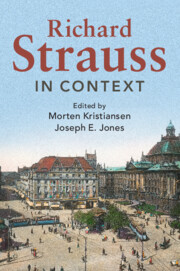Book contents
- Richard Strauss in Context
- Composers in Context
- Richard Strauss in Context
- Copyright page
- Contents
- Figures
- Notes on Contributors
- Preface
- Note on Translation
- Part I Family, Friends, and Collaborators
- Part II Career Stations
- Part III Cultural Engagement and Musical Life
- Part IV Professional and Musical Contexts
- Chapter 19 The Composer
- Chapter 20 The Conductor
- Chapter 21 The Orchestra
- Chapter 22 Program Music
- Chapter 23 Post-Wagnerian Opera
- Chapter 24 The Lied
- Part V In History
- Part VI Artifacts and Legacy
- Further Reading
- Appendix: Letters Bibliography
- Index
Chapter 24 - The Lied
from Part IV - Professional and Musical Contexts
Published online by Cambridge University Press: 08 October 2020
- Richard Strauss in Context
- Composers in Context
- Richard Strauss in Context
- Copyright page
- Contents
- Figures
- Notes on Contributors
- Preface
- Note on Translation
- Part I Family, Friends, and Collaborators
- Part II Career Stations
- Part III Cultural Engagement and Musical Life
- Part IV Professional and Musical Contexts
- Chapter 19 The Composer
- Chapter 20 The Conductor
- Chapter 21 The Orchestra
- Chapter 22 Program Music
- Chapter 23 Post-Wagnerian Opera
- Chapter 24 The Lied
- Part V In History
- Part VI Artifacts and Legacy
- Further Reading
- Appendix: Letters Bibliography
- Index
Summary
Political, social, technical, and cultural changes formed the context when Strauss composed a large part of his Lieder oeuvre between 1887 and 1906. The Liederabend had been established as a new concert format in the 1870s, shifting the genre’s performance environment from the private salon to the public stage, a development not without consequences for the genre itself. Strauss developed a personal style that clearly distinguished him from contemporaries such as Hugo Wolf, Gustav Mahler, or Max Reger. Seemingly untouched by the changes of his time at first glance, Strauss nevertheless reflected current affairs in some of his Lieder. This is true in particular for the year 1918, the last year of World War I, when Strauss took up composing Lieder after a twelve-year hiatus. When the aged composer later reflected upon his role in his construction of musical and cultural history, the Lied played a significant part within this process of self-affirmation.
- Type
- Chapter
- Information
- Richard Strauss in Context , pp. 218 - 226Publisher: Cambridge University PressPrint publication year: 2020

